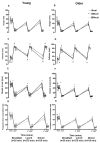Whey Protein Drink Ingestion before Breakfast Suppressed Energy Intake at Breakfast and Lunch, but Not during Dinner, and Was Less Suppressed in Healthy Older than Younger Men
- PMID: 33138061
- PMCID: PMC7693940
- DOI: 10.3390/nu12113318
Whey Protein Drink Ingestion before Breakfast Suppressed Energy Intake at Breakfast and Lunch, but Not during Dinner, and Was Less Suppressed in Healthy Older than Younger Men
Abstract
Ageing is associated with changes in feeding behavior. We have reported that there is suppression of energy intake three hours after whey protein drink ingestion in young, but not older, men. This study aimed to determine these effects over a time period of 9 h. Fifteen younger (27 ± 1 years, 25.8 ± 0.7 kg/m2) and 15 older (75 ± 2 years, 26.6 ± 0.8 kg/m2) healthy men were studied on three occasions on which they received, in a randomized order, a 30 g/120 kcal, 70 g/280 kcal whey-protein, or control (~2 kcal) drink. Ad-libitum energy intake (sum of breakfast, lunch, and dinner) was suppressed in a protein load responsive fashion (P = 0.001). Suppression was minimal at breakfast, substantial at lunch (~-16%, P = 0.001), no longer present by dinner, and was less in older than younger men (-3 ± 4% vs. -8 ± 4%, P = 0.027). Cumulative protein intake was increased in the younger and older men (+20% and +42%, P < 0.001). Visual analogue scale ratings of fullness were higher and desire to eat and prospective food consumption were lower after protein vs. control, and these effects were smaller in older vs. younger men (interaction effect P < 0.05). These findings support the use of whey-protein drink supplements in older people who aim to increase their protein intake without decreasing their overall energy intake.
Keywords: appetite; energy intake; gastric emptying; whey protein.
Conflict of interest statement
The authors declare no conflict of interest.
Figures





Similar articles
-
Effects of Age on Acute Appetite-Related Responses to Whey-Protein Drinks, Including Energy Intake, Gastric Emptying, Blood Glucose, and Plasma Gut Hormone Concentrations-A Randomized Controlled Trial.Nutrients. 2020 Apr 6;12(4):1008. doi: 10.3390/nu12041008. Nutrients. 2020. PMID: 32268554 Free PMC article. Clinical Trial.
-
The effects of whey and soy liquid breakfast on appetite response, energy metabolism, and subsequent energy intake.Nutrition. 2019 May;61:179-186. doi: 10.1016/j.nut.2018.11.007. Epub 2018 Nov 27. Nutrition. 2019. PMID: 30822749 Clinical Trial.
-
Acute effects of whey protein on energy intake, appetite and gastric emptying in younger and older, obese men.Nutr Diabetes. 2020 Oct 2;10(1):37. doi: 10.1038/s41387-020-00139-8. Nutr Diabetes. 2020. PMID: 33004790 Free PMC article. Clinical Trial.
-
Effect of Glycemic Index of Breakfast on Energy Intake at Subsequent Meal among Healthy People: A Meta-Analysis.Nutrients. 2016 Jan 4;8(1):37. doi: 10.3390/nu8010037. Nutrients. 2016. PMID: 26742058 Free PMC article. Review.
-
Effect of Protein-Rich Breakfast on Subsequent Energy Intake and Subjective Appetite in Children and Adolescents: Systematic Review and Meta-Analysis of Randomized Controlled Trials.Nutrients. 2021 Aug 18;13(8):2840. doi: 10.3390/nu13082840. Nutrients. 2021. PMID: 34445000 Free PMC article.
Cited by
-
Rational Use of Protein Supplements in the Elderly-Relevance of Gastrointestinal Mechanisms.Nutrients. 2021 Apr 8;13(4):1227. doi: 10.3390/nu13041227. Nutrients. 2021. PMID: 33917734 Free PMC article. Review.
-
The Acute Effects of Breakfast Drinks with Varying Protein and Energy Contents on Appetite and Free-Living Energy Intake in UK Older Adults.Geriatrics (Basel). 2022 Jan 30;7(1):16. doi: 10.3390/geriatrics7010016. Geriatrics (Basel). 2022. PMID: 35200521 Free PMC article.
-
A Randomized, Placebo-Controlled, Single-Center, Crossover Study to Evaluate the Effects of Pre-Meal Whey Protein Microgel on Post-Prandial Glucometabolic and Amino Acid Response in People with Type 2 Diabetes and Overweight or Obesity.Metabolites. 2025 Jan 16;15(1):61. doi: 10.3390/metabo15010061. Metabolites. 2025. PMID: 39852403 Free PMC article.
-
Appetite and Satiety Control-Contribution of Gut Mechanisms.Nutrients. 2021 Oct 17;13(10):3635. doi: 10.3390/nu13103635. Nutrients. 2021. PMID: 34684635 Free PMC article.
-
Short-term pre-meal whey protein microgel supplementation reduces postprandial glycemia and appetite in adults with overweight: An open-label randomised controlled trial.Obes Pillars. 2025 May 26;15:100183. doi: 10.1016/j.obpill.2025.100183. eCollection 2025 Sep. Obes Pillars. 2025. PMID: 40521305 Free PMC article.
References
Publication types
MeSH terms
Substances
Grants and funding
LinkOut - more resources
Full Text Sources

